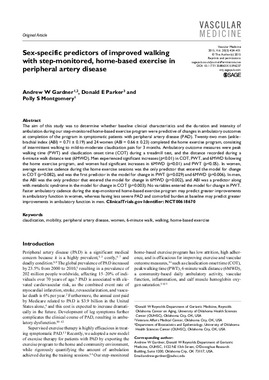| dc.contributor.author | Andrew W Gardner | |
| dc.contributor.author | Donald E Parker | |
| dc.contributor.author | Polly S Montgomery | |
| dc.date.accessioned | 2017-03-07T00:45:36Z | |
| dc.date.available | 2017-03-07T00:45:36Z | |
| dc.date.issued | 2015-08-03 | |
| dc.identifier.uri | https://hdl.handle.net/11244/49352 | |
| dc.description.abstract | The aim of this study was to determine whether baseline clinical characteristics and the duration and intensity of ambulation during our step-monitored home-based exercise program were predictive of changes in ambulatory outcomes at completion of the program in symptomatic patients with peripheral artery disease (PAD). Twenty-two men (ankle–brachial index (ABI) = 0.71 ± 0.19) and 24 women (ABI = 0.66 ± 0.23) completed the home exercise program, consisting of intermittent walking to mild-to-moderate claudication pain for 3 months. Ambulatory outcome measures were peak walking time (PWT) and claudication onset time (COT) during a treadmill test, and the distance recorded during a 6-minute walk distance test (6MWD). Men experienced significant increases (p<0.01) in COT, PWT, and 6MWD following the home exercise program, and women had significant increases in 6MWD (p<0.01) and PWT (p<0.05). In women, average exercise cadence during the home exercise sessions was the only predictor that entered the model for change in COT (p=0.082), and was the first predictor in the model for change in PWT (p=0.029) and 6MWD (p=0.006). In men, the ABI was the only predictor that entered the model for change in 6MWD (p=0.002), and ABI was a predictor along with metabolic syndrome in the model for change in COT (p=0.003). No variables entered the model for change in PWT. Faster ambulatory cadence during the step-monitored home-based exercise program may predict greater improvements in ambulatory function in women, whereas having less severe PAD and comorbid burden at baseline may predict greater improvements in ambulatory function in men. ClinicalTrials.gov Identifier: NCT00618670 | en_US |
| dc.language.iso | en_US | en_US |
| dc.publisher | Vascular Medicine | |
| dc.relation.uri | http://journals.sagepub.com/doi/full/10.1177/1358863X15596237 | |
| dc.subject | claudication | en_US |
| dc.subject | mobility | en_US |
| dc.subject | peripheral artery disease | en_US |
| dc.subject | women | en_US |
| dc.subject | 6-minute walk | en_US |
| dc.subject | walking | en_US |
| dc.subject | home-based exercise | en_US |
| dc.title | Sex-specific predictors of improved walking with step-monitored, home-based exercise in peripheral artery disease | en_US |
| dc.type | Research Article | en_US |
| dc.description.peerreview | Yes | en_US |
| dc.description.peerreviewnotes | https://us.sagepub.com/en-us/nam/manuscript-submission-guidelines | en_US |
| dc.identifier.doi | 10.1177/1358863X15596237 | en_US |
| dc.rights.requestable | false | en_US |
